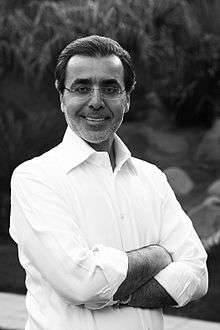Philanthropreneur
A philanthropreneur is an entrepreneurial philanthropist. The term is claimed to be coined by Internet entrepreneur Mark Desvaux in 2004;[1] however, The Wall Street Journal used the term in a 1999 article,[2] and a publication entitled The Philanthropreneur Newsletter existed as far back as 1997.[3] Philanthropreneurship is often considered the start of a new era in philanthropy, characterized by the development of the philanthropist’s role and the integration of business practices.



The core objective of philanthropreneurship is to increase the philanthropic impact of non-profit organizations. Traditionally non-profit organization solely depended on donations, grants, or other forms of charitable-giving. However, this new generation of entrepreneurs prefers to invest rather than donate. Philanthropreneurs are active donors whose role surpasses that of check writers. They leverage their resources to achieve social change that is both scalable and sustainable.[4] As a result, their contribution is meant to go beyond providing temporary "band-aid" solutions. Instead of directing efforts toward the purchase of medicine for the sick and the supply of food for the hungry, philanthropreneurs seek to eradicate the problem.[5]
Description
Philanthropreneurs are people who bring a creative or entrepreneurial approach to philanthropy. They are interested in effecting positive changes in the world and alleviating suffering, and do so in new and creative ways. Philanthropreneurs are often "driven to do good and have their profit, too", as Stephanie Strom wrote in a New York Times article.[6]
Theoretical framework of philanthropreneurship
As an emerging field there is no defined operating model or strategic approach. Still, philanthropreneurship marks the transitions from a grant-distributing model to a business-based model with predefined objectives and constant focus on quantifiable results.[7] This form of “commercial giving” demands measurable return, which is why opportunities are assessed and evaluated according to different criteria. Factors such as profitability and quantifiable performance are fixed requirements for granting support. The shift in professional management has also resulted in a greater focus on long-term goals.[7]
The application of entrepreneurial practices in philanthropy drives the impact of connected non-profit organizations through strategic funding. Traditional philanthropy encouraged the promotion of social welfare exclusively through charitable giving.[4] However, many well-intentioned projects fell through because of their disregard to set up revenue-generating strategies. In philanthropreneurship, prosperous ventures require the establishment of recurring income as a means of avoiding depletion of funds and ultimately preventing the social mission's dissolution.[8]
Philanthropic buying has a limited reach, which is why philanthropreneurs do not simply dispose of surplus funds, but strategically tailor investments by actively leveraging their resources (i.e. wealth, time, business expertise, networks, reputation, and prestige).[7] For example, Pierre Omidyar, chairman of eBay, started Omidyar Network because of his dissatisfaction with the level of impact his donations had through conventional charities.[6] Omidyar is an exemplar of how today’s philanthropists have taken on a greater role than their charitable predecessors. Apart from bringing their checkbook, affluent philanthropists are also expected to bring in their entrepreneurial know-how.
Philanthropreneurship has been described as the emerging practice of driving social change in new and creative ways. The term has been in use since 2014.[9] Practitioners — also known as philanthropreneurs or micro-preneurs — are entrepreneurial philanthropists. Philanthropreneurship is measured in impact, sustainability and scalability.[10]
Some practitioners — like Amr Al-Dabbagh in the Fortune article "How to Run Your Non-Profit Like a Startup"[11] — are deploying entrepreneurial business practices to help drive maximum impact, sustainability and scale.[12] Additional examples of practitioners — featured in The Guardian article by Rajesh Chandy ("Welcome to the New Age of Philanthropy: PHILANTHROPRENEURSHIP")[13]—include Bill and Melinda Gates, Steve Case, Pierre Omidyar and Bill Clinton. Stephanie Strom featured these practitioners and more in her New York Times article "What's Wrong With Profit?"[14] Philanthropreneurship is now supported by emerging new business models and legislation including low-profit limited liability companies (L3Cs), pioneered by tax attorney and entrepreneurial finance expert Marc J. Lane.
Controversies
Non-profit organizations have historically found it challenging to trust and accept the concept of "philanthro-capitalism". Critics note that many metrics of the commercial sectors, such as return on investment and other ratios, lack applicability to non-profit organizations.[7] Moreover, the inclusion of commercial and enterprise strategies has generated concerns in maintaining the institution's culture and ideology. A particular concern is the risk that the organization's focus will shift away from the social mission.[15]
Nonetheless, its success has piqued the interest of an increasing number of non-profit organizations, but the performance assessment of philanthropreneurial ventures remains an area of concern for many, as there is no precise measurement for social impact. For example, in "impact investing", a core practice of philanthropreneurship, project selection for funding is based on estimated social impact and financial return.[16] From an ethical context, many critics argue that the incorporation of a business model commercializes the nonprofit sector and further increases the risk of distorting the organization's mission and principles.[8]
Conversely, many supporters point out that traditional philanthropy alone cannot sustain social initiatives because of the shortage in sources of funding.[6] In philanthropreneurship, a dependency in traditional fundraising is a strong predictor of failure, which is why historically the implementation of business practices enables philanthropreneurship to outperform age-old practices of philanthropy.[17]
21st-century efforts
Playpumps International is a nongovernmental organization (NGO) founded by Trevor Field. Today the Playpump-initiative is made up of two for-profit entities and one nonprofit. Playpump International is a nonprofit in the U.S. that is partnered with Roundabout Water Solutions, a manufacturing company in South Africa.
The organization's mission is to promote public health in South Africa by providing easy access to clean, potable water in rural communities. Field designed a self-sustainable system that enabled water to be pumped into a storage tower. This model resulted in a mechanical water extraction process designed after a playground merry-go-round, which is attached to a water pump. Rotational energy generated by children playing is then used to fill the water storage tower. The system enhances living conditions and offers playing equipment for the young population. Since its invention, hundreds of water pump systems have been installed, particularly through the aid of monetary donations and governmental approvals.
Before Playpumps attained global recognition, the organization had to be self-financed in order to ensure its continuity. Because of the infrequent number of charitable donations received and lack of fundraising sources, Field sought to generate an alternative flow of income. Income was generated by marketing contracts. Four-paneled billboards concealed the Playpump water storage towers and were used to display printed ads. The purpose of generating revenue was to recapitalize on the cost of the equipment (i.e. manufacturing and installation costs). With time, monetary donations increased significantly, and thus allowed for half of each tower's panels to be dedicated to promoting social messages, specifically HIV and AIDS awareness.[18]
Practitioners of philanthropreneurship
- Amr Al-Dabbagh[19]
- Steve Case
- Bill Clinton
- Bill and Melinda Gates Foundation
- Pierre Omidyar
See also
References
- Magic Moments: Become a Philanthropreneur Archived 2007-09-27 at the Wayback Machine
- World Wide Words - Philanthropeneur
- Word Spy - Philanthropreneur
- Al-Dabbagh, Amr (2 February 2015). "How to run your non-profit like a startup". Fortune.
- Coppola, Marc (1 June 2016). "Rise of the Philanthropreneur: How Founders Are Finding Success While Doing Good". Foundr Magazine.
- What’s Wrong With Profit? - New York Times
- "Entrepreneurial Philanthropy: An Exploratory Review". Journal of Wealth Management. 17, 3.
- "Philanthropic Social Ventures: A Framework and Profile of the Emerging Field". Journal of Public Management & Social Policy. 18, 1.
- The Guardian on philanthropreneurship
- Philanthropreneurship Forum
- Fortune on How to Run Your Non-Profit Like a Startup
- Philanthropreneurship Forum
- The Guardian on Welcome to the New Age of Philanthropy: PHILANTHROPRENEURSHIP
- New York Times on What's Wrong With Profit?
- Constatino, Tor (21 May 2015). "A 5-Step Process for Success as a 'Philanthropreneur'". Entrepreneur.
- Brest, Paul (14 January 2016). "Does Philanthropreneurship Signal The End of Philanthropy as We Know it?". Philanthropreneurship.
- Chandy, Rajesh (8 December 2014). "Welcome to the new age of philanthropy – philanthropreneurship". The Guardian.
- "The Making of a "Philanthropreneur" (Interview with Trevor Field and Mark Melman, Playpumps International)". Journal of Values-Based Leadership. 1.
- (Al-Dabbagh Group)